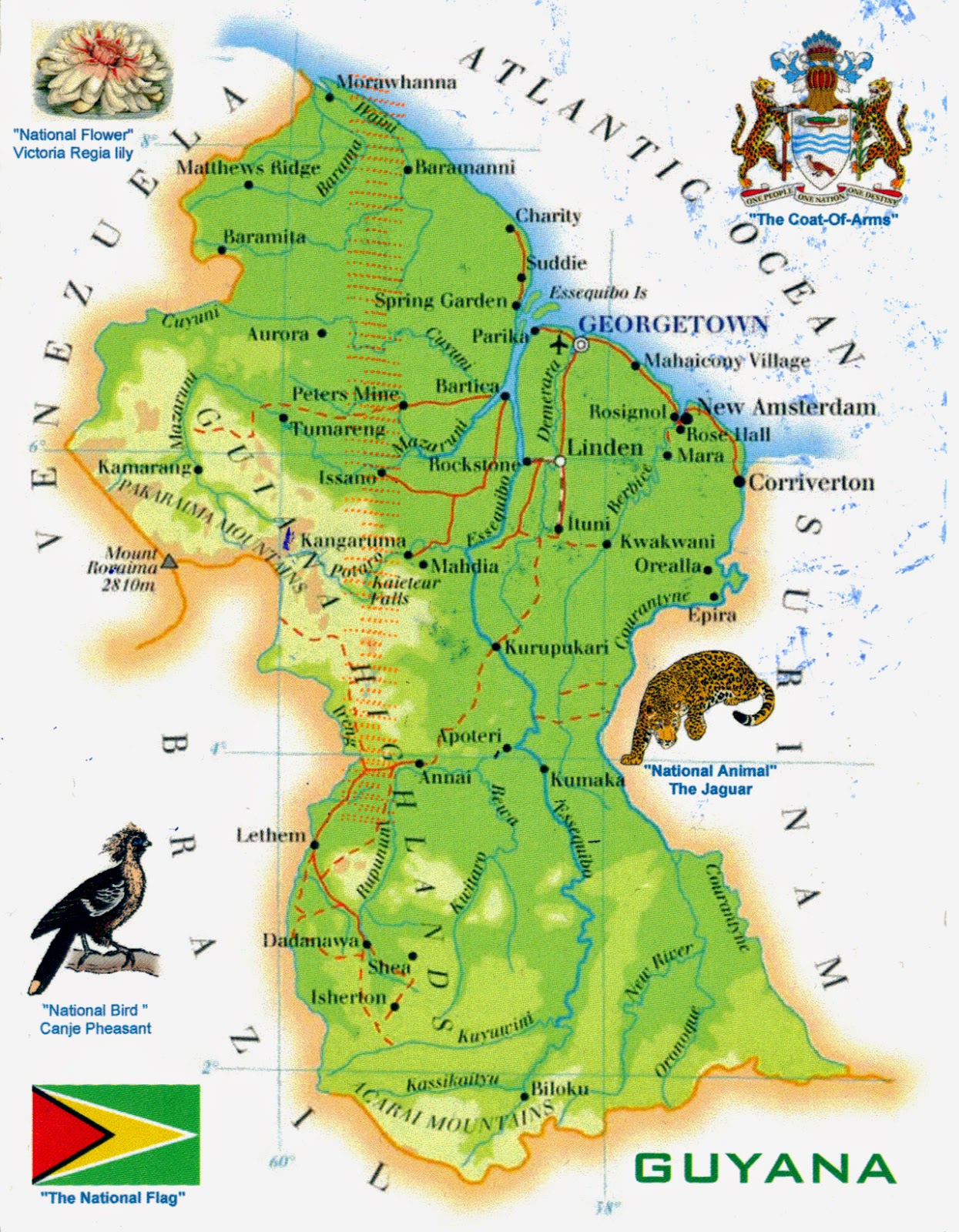 |
| 1472 - Guyana's map and national symbols |
Posted on 04.03.2014 and 28.02.2015
According to the Oxford English Dictionary, the name "Guyana" comes from an Amerindian word meaning "land of waters". Anyway, historically speaking, The Guianas (Las Guayanas in spanish) refers to a region in South America, north of the Amazon River and east of the Orinoco River, which includes French Guiana (an overseas department of France), Guyana (former British Guiana), Suriname (former Dutch Guiana), the Guayana Region in Venezuela (former Spanish Guyana), and Brazilian State of Amapá (former Portuguese Guiana). Guyana, officially the Co-operative Republic of Guyana, was originally colonized by the Netherlands, but became a British colony and remained so for over 200 years until it achieved independence in 1966, to become a republic in 1970.
 |
| 1022 - Guyana's flag |
It is the third-smallest independent state on the mainland of South America (after Uruguay and Suriname), and has a population of approximately 770,000 inhabitants, of which 90% reside on the narrow coastal strip. Racially and ethnically heterogeneous, with ethnic groups originating from India, Africa, Europe, and China, as well as indigenous or aboriginal peoples, its present population shares two common languages: English and Creole.
The country can be divided into five natural regions: a narrow and fertile marshy plain along the Atlantic coast, a white sand belt more inland, the dense rain forests, the desert savannah, and the smallest interior lowlands. More than 80% of it is covered by forests, from dry evergreen and seasonal forests to montane and lowland evergreen rain forests. It has also one of the highest levels of biodiversity in the world. The capital and largest city of Guyana is Georgetown, "Garden City of the Caribbean", founded in the 18th century on the Atlantic Ocean coast, at the mouth of the Demerara River.
The flag of Guyana, designed by the American vexillologist Whitney Smith and known as The Golden Arrow, was adopted in 1966. The colours are symbolic, with green for agriculture and forests, white for rivers and water, gold for mineral wealth, black for endurance, and red for zeal and dynamism. The coat of arms of Guyana, adopted in 1966, includes a crest of an Amerindian head-dress symbolizing the indigenous people of the country, this crest is also called the Cacique's Crown; two diamonds at the sides of the head-dress representing mining industry; a helmet (monarchial insignia); two jaguars (Guyana's national animal) as supporters holding a pick axe, sugar cane, and a stalk of rice (symbolizing Guyana's mining, sugar and rice industries); a shield decorated with the Victoria regia lily (Guyana's national flower); three blue wavy lines representing the three main rivers of Guyana; and the national bird, the Canje Pheasant (Opisthocomus hoazin). The national motto, "One people, One Nation, One Destiny", appears on the scroll below the shield.
About the stamps
On the postcard 1472
The first three stamps are part of the series Birds of the world, issued on May 8, 1995:
• Northern Goshawk / Accipiter gentilis (5 GYD)
• Northern Lapwing / Vanellus vanellus (6 GYD) - It's on the postcard 1472
• Long-wattled Umbrellabird / Cephalopterus penduliger (8 GYD)
• Slaty-headed Parakeet / Psittacula himalayana (15 GYD)
• Regent Bowerbird / Sericulus chrysocephalus (19 GYD) - It's on the postcard 1472
• Egyptian Goose / Alopochen aegyptiaca (20 GYD)
• Two-barred Crossbill / Loxia leucoptera (25 GYD)
• Bohemian Waxwing / Bombycilla garrulus (30 GYD)
• Ruff / Philomachus pugnax (35 GYD) - It's on the postcard 1472
• Eurasian Hoopoe / Upupa epops (60 GYD)
• Superb Starling / Lamprotornis superbus (100 GYD)
• Great Jacamar / Jacamerops aureus (500 GYD)
The last two stamps are part of the serie Birds of the World (Philakorea 1994), issued on August 16, 1994. All the stamps are the same face value (35):
• Northern Goshawk / Accipiter gentilis - It's on the postcard 1472
• Northern Lapwing / Vanellus vanellus
• Long-wattled Umbrellabird / Cephalopterus penduliger
• Slaty-headed Parakeet / Psittacula himalayana
• Regent Bowerbird / Sericulus chrysocephalus
• Egyptian Goose / Alopochen aegyptiaca
• Two-barred Crossbill / Loxia leucoptera
• Bohemian Waxwing / Bombycilla garrulus
• Ruff / Philomachus pugnax
• Eurasian Hoopoe / Upupa epops
• Superb Starling / Lamprotornis superbus
• Great Jacamar / Jacamerops aureus
• Peregrine Falcon / Falco peregrinus - It's on the postcard 1472
• Great Spotted Woodpecker / Dendrocopos major
• White-throated Kingfisher / Halcyon smyrnensis
• Andean Cock-of-the-rock / Rupicola peruvianus
• Yellow-headed Amazon / Amazona oratrix
• Victoria Crowned Pigeon / Goura victoria
• Little Owl / Athene noctua
• Common Pheasant / Phasianus colchicus
• European Goldfinch / Carduelis carduelis
• Eurasian Jay / Garrulus glandarius
• Keel-billed Toucan / Ramphastos sulfuratus
• Blue-and-white Flycatcher / Cyanoptila cyanomelana
On the postcard 1022
The stamp was issued in 2009 to honor 60 Years of the Commonwealth.
References
Guyana - Wikipedia
Coat of arms of Guyana - Wikipedia
Sender 1022, 1472: ???
1022: Sent from Georgetown (Guyana), on 11.02.2014
1472: Sent from Georgetown (Guyana), on 13.02.2015
.jpg)


.jpg)

Flag of Guyana
ReplyDeleteVery interesting information on the Guyana
ReplyDelete